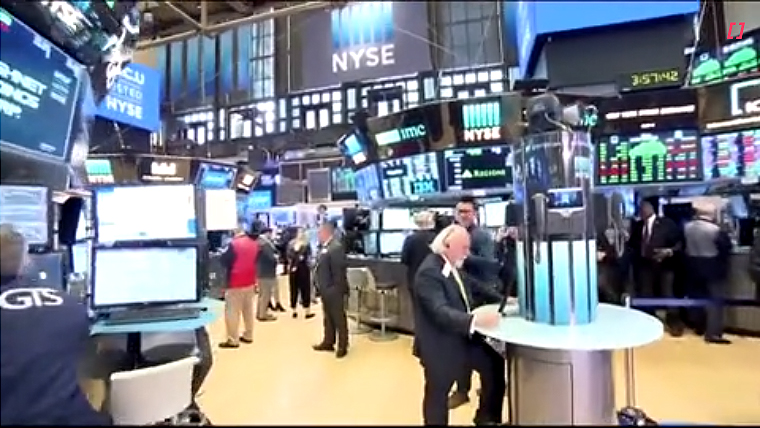
In the afterglow of the Fed’s jumbo 50bps rate cut, US equities show a strong lift to fresh record highs while the US Treasuries curve has steepened further, with longer term yields pushing higher, not helped by jobless claims falling and higher oil prices. The USD is broadly weaker. Against a backdrop of higher risk appetite, the NZD has recovered to 0.6250. GBP outperformed after the market pared rate cut expectations following the BoE’s on-hold decision.
Markets have embraced the Fed’s message that yesterday’s 50bps cut was from a position of strength, not weakness, as it attempts to engineer a soft-landing for the economy. Fed Chair Powell’s performance in selling the message was a masterstroke, with the market not worried that an initial 50bps cut signalled economic concerns. Risk appetite is higher and US equities are up strongly after the initial “meh” response post-meeting. The S&P500 is currently up almost 2% to a fresh record high while the Nasdaq index is up around 2.7%.
The US Treasuries curve has steepened further with the 2s10s gap now 14bps, the steepest since mid-2022, with the 2-year rate down a touch and the 10-year rate up a few bps to 3.74%. The market is pricing 36bps of cuts for the November meeting, so slightly favouring 25bps over 50bps, and 72bps over November/December so a high chance that at one of the remaining two meetings another 50bps cut is thrown into the mix.
US economic releases overnight were second-tier, but initial jobless claims unexpectedly fell by 12k to 219k last week, the lowest since May, although analysts note seasonal adjustment issues at this time of year around the Labour Day holiday so one shouldn’t jump to conclusions. The 10-year rate jumped up 5bps on the release, with the move only partially unwound. Existing home sales disappointingly fell by 2.5% m/m in August to a 10-month low while the Philly Fed manufacturing index rose 8.7pts to 1.7 in September, recovering less than half of the plunge in August.
Against a backdrop of higher risk appetite, although simmering tensions in the Middle East might also be a factor, oil prices continue to recover, with Brent crude up 1½% to near USD75 per barrel, after trading at a low of sub USD70 ten days ago.
In other key news, the Bank of England voted 8-1 to keep policy steady, as expected, opting to skip a rate cut this meeting and guide to November for a second rate cut this cycle. The outlook statement added “In the absence of material developments, a gradual approach to removing policy restraint remains appropriate”, while leaving the comment “Monetary policy will need to continue to remain restrictive for sufficiently long until the risks to inflation returning sustainably to the 2% target in the medium term have dissipated further.”
The BoE’s patient approach to cutting rates reflects some ongoing unease about residual inflation pressure, with services sector CPI running at 5.6% y/y. The market fully prices a 25bps cut in November and 43bps by year-end, a modest paring of rate cut expectations compared to pre-meeting. The modest lift in UK gilt yields across the curve supported GBP and it traded at a fresh 2½ year high just over 1.33 before settling below the figure.
The USD is broadly weaker in the aftermath of the Fed rate cut and the NZD has been supported against the backdrop of increased risk appetite. The NZD has recovered overnight to around 0.6250 after probing just under 0.6270, similar to the level reached in the minutes after the Fed’s announcement, possibly signalling a new level of short-term resistance. The AUD has settled above 0.68 and NZD/AUD has settled around 0.9165.
Against a backdrop of higher risk appetite, JPY has underperformed although after a run towards 144, USD/JPY is back down to 142.60. NZD/JPY is up through 89. While EUR is higher, NZD/EUR has pushed up to 0.56.
Yesterday, Australia employment grew by a robust 47.5k in August, meeting strong growth in labour supply to keep the unemployment rate steady at 4.2%. Some traders were clearly hoping for a weaker outcome that would justify an RBA rate cut this year, but there was nothing in the report to justify a change in RBA view, resulting in higher rates and a stronger AUD.
NZ Q2 GDP contracted by 0.2% q/q, slightly less than most expected, but consistent with the narrative that the economy has been rolling in and out of recession for the past couple of years, resulting in a building up of spare capacity and falling inflation pressures.
The domestic rates market had a rollercoaster ride, with global forces pushing up yields into the afternoon, before reversing a lot of the move late in the session. The net result was swaps closing up 2-3bps, while tepid demand at the bond tender resulted some notable curve steepening in NZGBs, with short end rates up 1bp but longer-term rates up 5-6bps. The Australian 10-year bond future is up 3bps in yield terms since the NZ close.
In the day ahead, the focus turns to Japan, with CPI data released ahead of the BoJ’s policy meeting announcement. CPI inflation figures are expected to push higher but no one expects the BoJ to hike again, so soon after the end-July hike, with a majority expecting the next hike at the December meeting.




We welcome your comments below. If you are not already registered, please register to comment.
Remember we welcome robust, respectful and insightful debate. We don't welcome abusive or defamatory comments and will de-register those repeatedly making such comments. Our current comment policy is here.